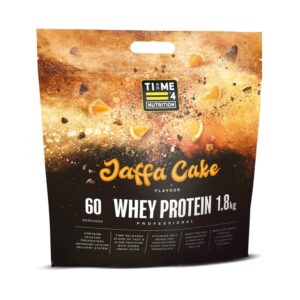Protein Powder & GI Distress…. Is Lactose Always To Blame?
Protein Powder & GI Distress…. Is Lactose Always To Blame?
Protein Powder & GI Distress – Carboxymethylcellulose (CMC)
By Brian Batcheldor BSC
(Click On The Reference Numbers In Blue For More Info)
With all of the high-quality ingredients in new Time 4 Whey Professional, one of the easiest benefits to overlook is its sheer digestibility. As someone who gets around 50% of his daily protein intake in supplemental form, to be able to do this with zero discomfort is a major bonus, it’s not something I’d normally experience and the feedback from others in this regard has been nothing but positive. With anywhere near this amount of protein per serving, most protein powders would generate some degree of discomfort amongst consumers and when this occurs you can be sure that the first thing they’ll put it down to is the lactose content. However, if you are lactose sensitive or intolerant or perhaps even have a (cows) milk allergy, then you likely would have already been aware of this from having previously had a similar unpleasant experience with other dairy (food) products, -why assume that a protein powder would be any different? This would be a good time to go over the label carefully and scrutinise the other ingredients (dairy and otherwise) in the formula, providing of course that the information can be trusted. There are several common inclusions that could cause GI distress or exacerbate an existing condition, like IBS or Celiac Disease, -peptide bonded glutamine (PBG) is just one. In a previous article on the Time 4 Nutrition site, I covered the reasons why we decided to drop this ingredient when we launched our breakout Time 4 Whey Professional formula. Displacing high quality dairy proteins, peptides and amino acids with any amount of inferior hydrolysed wheat no longer made sense, -the value of a couple of extra grams of glutamine certainly doesn’t mitigate the potential impact of this havoc-wreaking inflammatory allergen. I also wrote an exposé on supplement shrink flation, -the growing trend of cutting protein supplements with cheap skimmed milk powder. I suggest you jump on the Time 4 site and get a heads up on this cheapskate lactose-loading adulteration from the key figures representing the supplement industry in that interview, including David Jenkins, former owner of the Next Nutrition, Designer Whey and Ultimate Orange brands, -three of the most famous brands in supplement history.

Protein Powder & GI Distress – Carboxymethylcellulose (CMC)
Once you’ve checked these two suspects off the list (lactose and PBG), you may want to scan the ingredients panel for Carboxymethylcellulose (CMC).
What is Carboxymethylcellulose and what is it doing in my protein powder?
Carboxymethylcellulose (CMC) is a common and widely used ingredient found in many convenience foods today. As it is derived from plant cellulose, it’s often seen in vegan food products and supplements, where it’s valued for its ability to form gels and hold water. When it comes to protein powders and MRPs, Carboxymethylcellulose (CMC) is a very common addition for the following reasons:
Texture Enhancement: One of the primary reasons for incorporating Carboxymethylcellulose (CMC) into powdered food supplements (protein powder, post workout, etc) is to improve their texture. CMC acts as a thickening agent, providing a smooth and consistent mouthfeel and preventing clumping of ingredients.
Stability and Shelf-Life Extension: Carboxymethylcellulose (CMC) helps to stabilize powdered food supplements by preventing ingredient separation, moisture absorption, and microbial growth. It forms a protective film around the particles, which inhibits the migration of water and oils, thereby preventing spoilage and maintaining the product’s quality. This feature is crucial for extending the shelf life of powdered supplements, ensuring that they remain safe and effective for consumption over the entire shelf life.
Improved Solubility: Powdered food supplements often contain insoluble active ingredients that need to be dissolved in liquid before consumption. Carboxymethylcellulose (CMC) enhances the solubility of such ingredients by increasing their dispersibility and preventing separation. This property facilitates the quick and complete dissolution of the supplement in water or other liquids, enabling efficient nutrient absorption by the body.
Binding and Homogeneity: Carboxymethylcellulose (CMC) acts as a binder, helping to hold the powdered ingredients together during manufacturing processes, such as granulation and tableting. It ensures that the components are evenly distributed, preventing ingredient segregation and vitally preserving the original uniform suspension of a powdered supplement when mixed with liquid. The distribution of active ingredients (e.g., amino acids. plant extracts, vitamins) needs to be even throughout the solution to provide reliably accurate dosing per serving without any settling.
Potential For Unwanted Side Effects: As I’ve already indicated, CMC is generally regarded as safe for consumption in the short term, it’s also a versatile and useful ingredient in clinical nutrition and the wider medical field, e.g., wound dressings and medicines. Lactose could also fit into several of the same categories, -we know how that’s worked out for many, so we shouldn’t be under any illusion that there are individuals who will experience unpleasant side effects with CMC, these include:
Gastrointestinal Disturbances: In some cases, individuals may experience gastrointestinal discomfort, such as bloating, gas, or diarrhoea, after consuming products containing CMC. These effects are generally mild and transient, resolving on their own without any long-term consequences. If this is a persistent response to protein powders, it’s worth getting a medical opinion and some sort of food allergy testing done.
Allergic Reactions: While rare, hypersensitivity or allergic reactions to CMC have been reported in a few cases. Symptoms may include skin rashes, itching, swelling, or difficulty breathing. Individuals with a known allergy to CMC or other related compounds should avoid products containing CMC or consult a healthcare professional before consumption (1).
Interference with Medication Absorption: CMC’s ability to enhance solubility and absorption may affect the bioavailability of certain medications if consumed simultaneously. It is crucial to consult a healthcare professional or pharmacist to assess any potential drug interactions or alterations in medication absorption when considering the use of powdered food supplements containing CMC.

Protein Powder & GI Distress – Carboxymethylcellulose (CMC)
There are also the long-term considerations with CMC, e.g., how would CMC impact the microbiome with regular use (2). CMC wouldn’t exactly be the first emulsifier indicated to adversely impact intestinal health through the promotion of gut bacteria dysbiosis and disease and subsequent driving of chronic intestinal inflammation (3, 4). This kind of widespread use has thus always been something that is recommended for periodic review according to science, indeed, any new application for a novel use for CMC is usually met with a string of attachments relating to additional studies and data collection. This approach has already added more concern with the recent indication that the CMC impact on the microbiome may increase the expression of genes linked with obesity (5).

Protein Powder & GI Distress – Conclusion
Whilst the word “quality” is commonly bandied about when explaining the addition of ingredients like CMC, this purely relates to the presentation/cosmetic aspects (taste, appearance and how easy it is to blend) of the finished product, -it should not be confused with the quality (grade) of the ingredients used in the formula. Sure, the role of ingredients like CMC in improving the overall experience of using a protein powder is important, -its textural enhancement, stability, solubility, and binding properties all contribute to the success of the product, -they provide the perception of a quality product. However, its worth remembering that whilst some well-meaning companies may use CMC in their battle to gain early acceptance of an innovative ingredient or concept against the unconquered challenge of poor palatability, plenty others will use CMC to conceal the poorest quality ingredients behind the veneer of a fast-food chain thick shake. The good news is that you don’t have to suffer unpleasant side effects just to use a decent tasting protein powder any longer. Meeting the demands of a more science-savvy consumer, whilst also having to address the allergenic and digestive concerns experienced by some, innovative companies today are turning to more functional ingredients, like acacia gum, a prebiotic fibre that brings texture enhancement but replaces bloat and GI distress with reduced gut inflammation.

